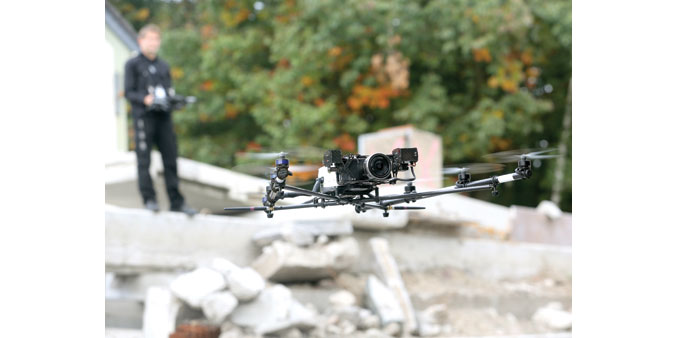FAA’s lack of speed in crafting regulations allowing
commercial and private drone flights is not sitting well with
enthusiasts and professionals. By Cameron Mackintosh
How can a photograph ever capture the majesty of a humpback whale? Imagine a camera capable of floating in mid-air, mere metres above the clear water’s surface, just as a pod of whales breaches directly beneath the lens.
For drone videographer Eric Sterman, this mystical experience became a reality when, in April, he used his GoPro camera-mounted drone to take breathtaking aerial images of a group of whales frolicking in the waves off the coast of Hawaii.
Sterman is one of many photographers and videographers making use of the recent proliferation in affordable drone technology.
But while this exciting new field has blossomed all over the globe, the United States is falling behind in the realm of aviation for the first time ever.
The government is fining people who make money off drone-captured images, because under current US law, commercial drone use is illegal. Recreational use is however permitted.
In 2012, Congress mandated that the Federal Aviation Administration (FAA) produce regulations to fully allow safe commercial and private drone flight in US airspace by September 2015.
But the FAA is “significantly behind schedule” and won’t meet Congress’s deadline, according to a report by a government inspector general.
Drone users around the country meanwhile are using their technology anyway, fostering a sense of lawlessness in the skies.
“People are getting used to ignoring the rules,” Timothy Reuter told dpa. “The longer people get used to ignoring the rules, the harder it will be in the future to enforce FAA policy.”
Reuter is the president of the DC Area Drone User Group, one of many communities in America dedicated to the new drone subculture.
Nearly two dozen accidents and crashes involving drones have been reported in the US since 2009, a Washington Post investigation revealed. Even in the expert hands of the US military, nearly 50 drones have crashed over populated areas while on test flights in US airspace.
There have even been reports of drones hovering in the flight paths of commercial passenger planes coming out of busy airports such as Los Angeles and New York.
Along with the obvious safety issues, the risk that privacy will be violated by spies in the sky has also been a central concern over the drone proliferation.
The need for regulations is pressing. Experienced drone fliers are willing to co-operate with the FAA.
“We want to create a culture of safe and socially beneficial flying practices,” Reuter said.
“I want the regulations,” said Parker Gyokeres, a US Air Force veteran who flies drones for Propellerheads, a pioneer in the emerging field of aerial photography.
Gyokeres, like many, has high hopes for the future of commercial drone technology and is frustrated with the FAA’s reluctance to integrate the little machines into the airspace.
“I want to show people the favelas in Rio. I want to show people pollution. I want to show people what deforestation looks like from a perspective they’ve never seen before,” Gyokeres said at a recent panel discussion. “I want to make a difference, but I’m not allowed to.”
Recreational drone use is permitted by the FAA, as long as pilots adhere to 1982 guidelines for model aircraft, which restrict altitude to 400 feet and require the pilot to keep the aircraft in the line of sight.
But civilian drones, costing as little as 500 dollars, have much to offer society outside of recreation. They are helping to catch poachers in Kenya, inspect oil rigs in the Arctic, and search for typhoon survivors in the Philippines.
Non-profit Texas Equusearch, which specialises in finding missing persons, has started using drones.
It was able to locate the body of a 2-year-old boy after just 10 minutes of flying time, said Brendan Schulman, an attorney who has defended drone users against thousands of dollars of FAA fines.
Texas Rangers had come up empty handed, despite five days of prior searching for the boy.
The economic potential for commercial drone use is also impressive.
“This industry is poised to create 100,000 jobs and over 80 billion dollars in economic impact within the next decade,” Ben Gielow, a spokesman for the Association for Unmanned Vehicles and Systems International (AUVSI) said.
“But every day that the FAA is late will cost the economy 27 million dollars in lost economic potential.”
Reuter is impatient with the FAA’s slow progress, saying it is sometimes easier for a regulatory agency “to just say no to everything.”
Melanie Hinton, a spokeswoman for AUVSI, was more diplomatic, telling dpa that her organisation understood that the FAA “wants to ensure that proper regulations are in place ... before they are more widely used or are flown in situations that may pose greater safety concerns than those in which hobbyists operate.”
The FAA has set up six test sites to establish rules for drone airworthiness and pilot certification. Small commercial flights have been allowed in the Arctic and in the film industry.
“Drone use is allowed by public agencies, such as universities and law enforcement, through individual certificates of authorisation,” said Hinton. The FAA has issued 545 of these certificates since December, according to the website.
Drones are being legally used for commercial purposes in countries such as Australia and Japan.
“Commercial drones have not, to my knowledge, created any serious safety issues in other countries,” said Reuter. “This is pushing innovation out of America.” —DPA



